Commercial property: reasons to be cheerful


A Scottish Retail Consortium (SRC) report this month cast some further gloom, highlighting how Scotland’s shop vacancy rate was up from 9 to 9.2 per cent between January and April, described as a “modest but nonetheless worrying” increase by the organisation.
These statistics are consistent with an emerging pattern over recent years, indicating a decline in the traditional retail sector as we know it.
Advertisement
Hide AdAdvertisement
Hide AdThe demise of long-established businesses, combined with the rise in online shopping is also creating challenges within the commercial property sector, which relies on a strong retail presence as many shop units are let to retailers who pay rent to commercial landlords. But there are reasons to be cheerful.
Here in Scotland, the Edinburgh St James redevelopment serves as a prime example of a key trend in the sector.
The scheme, which will boost Edinburgh’s place in the UK retail rankings from 13th to eighth, is replacing the 1970s shopping centre with 850,000sq ft of retail space, a luxury hotel, up to 150 homes, 30 bars and restaurants and a multi-screen cinema.
A number of well-known retail, leisure and hospitality operators have already committed to the development, underlining a gradual move away from dated and inflexible high street units towards bigger ones that are easier to reconfigure.
The transformational redevelopment also epitomises the trend towards place-making.
People are still coming into city centres – the SRC also reported a 3.2 per cent increase in shopper numbers in April, the fastest growth rate seen in Scotland since July 2014.
This rise is mainly in “destination” shopping areas in and around the big cities where retailers are focusing their attention on larger flagship branches complemented by restaurants and leisure facilities.
This does lead to more vacant units in other areas coming on to the market, some of which are being taken over by smaller independent retailers, from discounters through to high-end fashion, depending on the locality’s social and economic vibrancy, with others converting to leisure or residential.
Advertisement
Hide AdAdvertisement
Hide AdThe rise of internet shopping is also having some positive impact on retailers’ property requirements.
With consumers first researching online then often buying in store, physical stores are increasingly important as shop windows to showcase goods.
Innovations such as Amazon Go stores, where customers using a smartphone app can make purchases without having to queue, mean the line between online and traditional retail is blurring, creating opportunities for retailers who can deliver the multi-channel experiences customers want.
Provided attention is given to providing parking and transport links, footfall in city centres can continue to thrive.
The City of Edinburgh Council’s plan is that visitors coming in by car will park at the east end (the Edinburgh St James redevelopment will include 1,600 parking spaces) or the west end, and then access the city centre on foot.
Recent statistics show a mixed picture for retail; while the number of vacant units appears to be on the rise, so is consumer footfall in city centres and retail parks.
This points to a challenging but overall positive future for the sector where mixed-use centres, such as Edinburgh St James, will play an important role.
Roland Smyth is of counsel and
real estate specialist at law firm
CMS